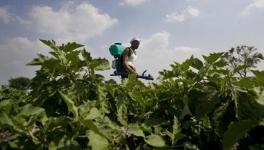Genetic Modification Technologies: Who should Control it?
While the controversy on genetically modified foods rages in India, very similar issues are being debated in many parts of the world. In India the contention is around the permission sought to be given for introduction of a modified form of Brinjal, called Bt Brinjal. A very similar debate is now raging in Europe, where a genetically modified form of rice is being sought to be introduced by Bayer. At the heart of the debate surrounding genetically modified food, lie several contentious issues. These relate to concerns about safety when GM foods are consumed by humans, the impact on naturally occurring species when GM crops are cultivated on a large scale, and the control of such technologies by giant multinational corporations.
Changing Nature is not a Recent Phenomenon
In order to understand the different dimensions of all these issues, we need to understand the technology that goes into the production of genetically modified plants and other living organisms. Humans are unique on this planet in that they are the only species that have developed the capability to actively change the way in which nature works to produce and nurture a large variety of living organisms. Other species also cause changes in nature -- for example grazing animals can change patterns of plant cover, insect populations can predate upon and destroy specific plant species, etc. But only humans are capable of directing changes in nature, with the conscious intent to bring about changes in existing living organisms.
This endeavour by human beings is by no means recent. All the food that we consume are derived from plants and animals that have been changed in particular ways through the method of selective breeding. The early varieties of “wild” maize, wheat and rice that the early humans cultivated, have been transformed by selective breeding into varieties that have desired characteristics. Such characteristics may have to do with better survival of a plant variety in a specific agro-climatic region, better yields, better perceived qualities such as aroma, taste, etc.
Let us for example examine the history of rice cultivation – arguably the most important food grain in the world. It is believed that rice was first domesticated in the Yangtze river valley about 12,000-11,000 years ago. Domestication followed the earlier practice of collection of the grains of wild rice that grew in the wild. Within a few thousand years, two distinct varieties (known as indica and japonica today) were being cultivated in Central China. From there it is believed to have traveled to South East Asia, and South Asia about 5,000 years ago. Farmers have continued to breed for desired qualities, giving rise to the large variety of rice today, ranging from the sticky rice consumed in Japan to Basmati rice cultivated in India and Pakistan. All of these had there origins in the wild grass that grew more than ten thousand years ago in Central China. Selective breeding has been utilised in the case of a large variety of domesticated animals as well. That is the reason we see such a variety of cattle, horses, dogs, etc. around us. Over a period humans added to their repertoire the process of hybridisation, to produce desired plant varieties. It differed from selective breeding in that new varieties were developed by breeding between two different varieties.
How GM Technologies are Different
The technology of selective breeding and hybridisation is possible because of the way in which living beings are constructed. All living organisms have within their cells, genes, that determine its diverse characteristics. Even within the same species, no two individuals are exactly similar. This is easy to understand if we look around and see how different two human beings can be, even though they are members of the same species. This is also the case with plants and animals. The reason for the differences lie in the genes – while the genes of two individuals in a species are very similar, they are never exact copies. If we remember that a living organism has hundreds of thousands of genes, it is easy to understand that a difference in even a few hundred of them can result in two very different individuals. This is the underlying explanation regarding how selective breeding or hybridisation works. Thus, in a large field of rice, a few plants would grow taller than the others – which means that these plants have genes that make them grow tall. If the farmer were to save the seeds of only these plants and grew them the next season, he would get a larger number of plants that were taller. Over several generations he would have produced a variety that would be taller than the variety he started with. In the case of hybridization, the farmer would cross two different varieties with characteristics he wants to preserve. He could , for example, cross a variety that is drought resistant with one that provides high yields. The resulting species would have both the desired qualities.
How then is genetically modified varieties different from what has been produced by humans for thousands of years? The perceived need for genetic modification arose from the fact that the techniques discussed above still depend on nature to do most of the work. A farmer can try to select for, say a tall variety of grain, but he is never sure that he will always get a new variety that is better. He may also end up with a taller variety, but that which has other undesirable qualities that he does not want. This uncertainty is related to the thousands and thousands of genes in any variety and the extremely complex way in which they interact and produce the characteristics of an individual. Moreover, the process takes many years, and generations of breeding before a satisfactory new variety is produced. Genetic modification arose as a method of “short circuiting” this process. It also arose in a situation when we now understood much better how genes work, as well as with the development of techniques that can actually change one or a few genes inside a living organism. Techniques for genetic modification, thus, substitute the “mixing of genes” that nature does with actual manipulation of the genes inside a laboratory.
Genetic modification involves the insertion or deletion of genes inside the cell of a living organism. The genes, thus transferred could be derived from the cells of an organism of the same variety – this process is called cisgenesis. Alternatively, the transferred genes could be derived from an entirely different species – this process is called transgenesis. To do this, there are procedures which involve attaching the genes to a virus or physically inserting the extra gene into the cell of the intended host with a very small syringe, or with very small particles fired from a gene gun. Other methods exploit natural forms of gene transfer, such as the ability of Agrobacterium (a naturally occurring bacteria) to transfer genetic material to plants, or that of lentiviruses to transfer genes to animal cells. As we can now see, genetic modification can do what nature can never (or very rarely) do – i.e. transfer the genes of one species into another.
We can understand better how the technology is utilised if we take the case of Bt Brinjal. Bt Brinjal is a modified variety of Brinjal created by the insertion of a gene [Cry 1Ac] from the soil bacterium Bacillus thuringiensis (hence the name Bt) into Brinjal. The gene is inserted into the Brinjal cell using Agrobacterium. The Bt gene makes the Brinjal plant produce a toxin that is harmful to common pests that afflict Brinjal crops, such as the Brinjal Fruit and Shoot Borer (Leucinodes orbonalis) and Fruit Borer (Helicoverpa armigera). The underlying theory is that if the Brinjal plant is protected from common pests in this manner crop yields will be better and the need for insecticides would be reduced. The technology has been developed by the giant agri-biotech multinational corporation – Monsanto. In India the trials on Bt Brinjal have been conducted by Mahyco -- Maharashtra Hybrid Seeds Company. Mahyco is part of a joint venture with Monsanto, through Mahyco-Monsanto Biotech.
Several Critical Concerns
The concern that has been raised regarding introduction of genetically modified varieties in nature relates to the possible impact on natural varieties. Experience now shows that there is no fool proof method of avoiding contamination of naturally occurring varieties with genetic material from genetically modified ones. Once the GM varied is allowed to be cultivated on a large scale, it would eventually, transfer some of its genetic material to natural varieties growing in other fields. This means that, over time, as more and more GM plants are introduced into nature, existing varieties would incorporate their genetic material. This could be a concern if we are not completely sure about the long term harmful effects of an artificially introduced gene, in terms of its long term survival and other characteristics. So, theoretically, an artificially inserted gene may cause the destruction of the entire crop, or may have other harmful ecological effects, for example on insects that help in pollination. As other natural varieties are also likely to be contaminated, there would then be no turning back. One the crop is out in the open and widely cultivated, there is no way of recalling it. This is why very stringent tests, at the stage of development of a GM variety, are necessary, to allay fears that the inserted gene that is set loose on nature will not fundamentally damage nature itself.
Moreover, GM technologies lend themselves to monoculture and erosion of biodiversity. With widespread use of GM plant varieties, huge swathes of land may be taken up plantations of GM crops. The danger of severe dislocations in food supply, if the variety were to fail, is something that needs to be factored in. Such a danger is a powerful reason to institute steps to protect the diversity of plant varieties that still exist in the planet.
The second concern particularly relates to those GM varieties that are intended for human consumption. For obvious reasons, we need to be cautious that GM plants that are used for food, do not cause harm when ingested by humans. Over thousands of years, humans have leant through experience, which plants are fit for human consumption. Here we seek to compress the process into a short span of a few years. Thus, transparent and clear evidence needs to be produced to show that the new GM variety being introduced does not cause harm to humans when they are introduced. Further, different countries have different ways of dealing with regulations related to GM foods, once they are allowed to be marketed. The United States and Canada do not require labeling of genetically modified foods. However the European Union, Japan, Malaysia and Australia require such labeling so consumers can exercise choice between foods that have genetically modified, conventional or organic origins. This requires a labeling system as well as the reliable separation of GM and non-GM organisms at production level and throughout the whole processing chain.
The difference in approach is evident from the fact that GM crops account for only 0.05% of total area under cultivation in the EU while it constitutes 18% of US agriculture. The US produces 96% of the world’s edible GMOs and is the principal driver of GM foods across the world. The European approach, in a nutshell, is that because we don’t know enough about the technology, long-term assessments of the environmental and health impact are necessary. Clearly, there is no single consensus today on how GM foods are to be used or regulated and many countries leave the choice to individual consumers. In India too, we need to develop our own guidelines based on a public debate.
The third, and perhaps most important concern, relates to the control of GM technologies. Today biotechnology has become the preserve of giant transnational corporations, and they control much of the technology. This holds true for technologies related to genetic modification of plants as well. GM technologies have the potential to transform the vary nature of agriculture, especially in developing countries such as India. Traditionally farmers save seeds from their fields, to be used in the next season. Farmers also share seeds among themselves, using a variety of arrangements. The technology of hybridisation changed many of these practices, as farmers now have to buy hybrid seeds from seed companies or depend on Government supplies. GM technologies are poised to add another layer of dependency, where farmers would have to depend on global monopolies such as Monsanto. The scenario of a few giant corporations controlling agriculture across the globe, and deciding who can eat and who shall starve, is to say the least, frightening. The concern is also linked with the manner in which the public funded research system in India is being increasingly made subservient to the needs of private corporations, many of them foreign owned. If India really wishes to take advantage of advances in science and technology they have to based on local needs and need to be backed up by indigenous efforts at developing our own technologies. A short cut, that is predicated on dependence on transnational corporations, especially in an area such as food, is fraught with obvious dangers.
On Whose Side is the Government?
The present debate on Bt Brinjal in the country straddles all the major concerns we list above. At the heart of the issue is the fact that there are serious apprehensions that Monsanto and its partner in India have not been transparent in disclosing the findings of their trials related to safety and economic benefits of Bt Brinjal. For good reasons, many are also suspicious of the complicity of the present Government in such a non-transparent process, given its public acknowledgment of a pro business mindset. When Sri Jairam Ramesh laments that the debate on Bt Brinjal has become one between pro and anti technology groups, he is missing the mark completely, perhaps deliberately. The debate is on who controls the technology and on whose side the Government is – on the side of the people or on the side of corporations such as Monsanto.
Get the latest reports & analysis with people's perspective on Protests, movements & deep analytical videos, discussions of the current affairs in your Telegram app. Subscribe to NewsClick's Telegram channel & get Real-Time updates on stories, as they get published on our website.



















